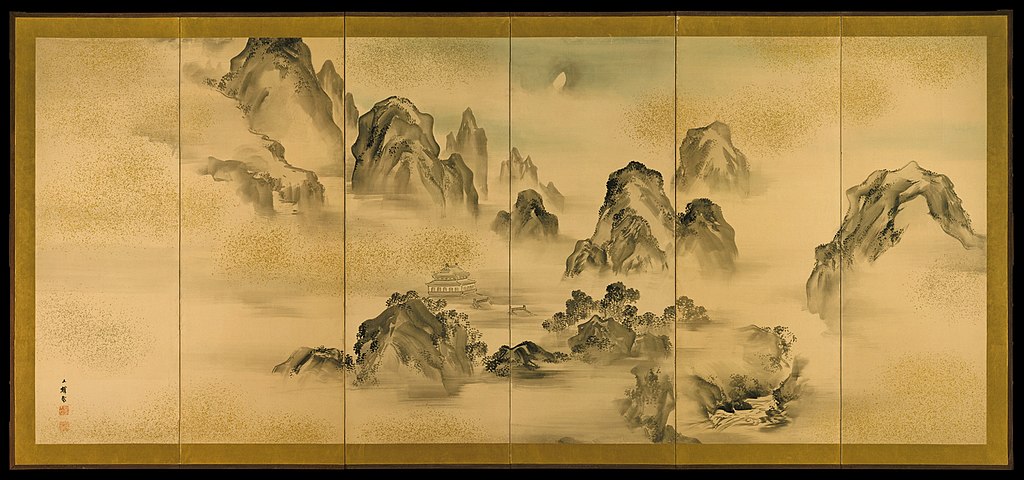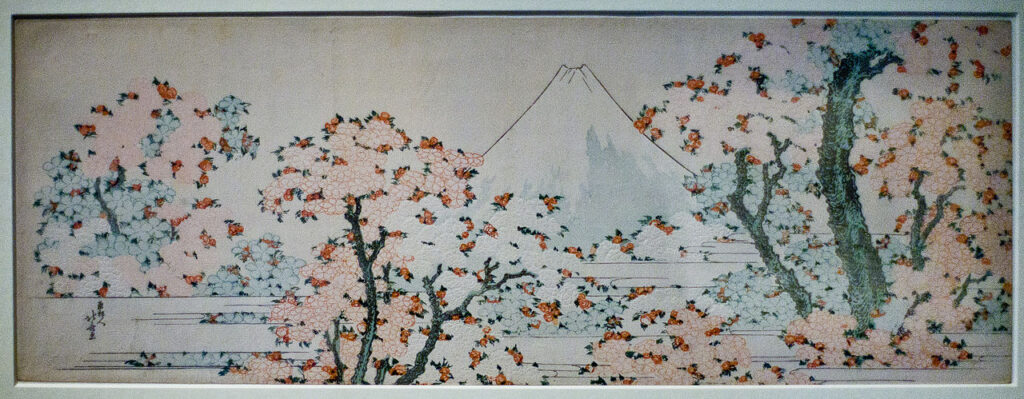
“In short, the world itself where we live as being-in-the-world is inherently twofold and essentially twofold in the invisible way. We are ‘located within’ (oite aru) the world and because of that, at the same time, we ‘are located within’ the unlimited openness or the invisible hollow expanse (koku) where the world is” (Ueda Shizuteru).
In his detailed study of Ueda’s borrowings from Heidegger and Nishida, Hironobu Ota notes that, in general terms, “Ueda treats the concept of world through an interpretation of Heidegger and the concept of self through the philosophy of Nishida.” But he also adds that, in many instances, a concept borrowed from Heidegger is modified by a parallel concept from Nishida. For instance, “the idea of ‘hollow expanse’ is a synthesis of Nishida’s place and Heidegger’s openness (Offenheit).” For each of Ueda’s concepts, it will be a matter of teasing out how one source was blended with the other.
Invisible Twofoldness of World: World and Nothingness in Heidegger
With regard to his debt toward Heidegger, in addition to his borrowing of the term “In-der-Welt-Sein” (“being-in-the-world”), which allows him to overcome the subject-object dichotomy, Ueda also draws on Heidegger’s concept of the world as a “totality of significations,” (Bedeutungsganze) which he calls “an encompassing space of meaning.” Ota writes that, for Heidegger, “since the appearance of beings passes through a pattern of articulation, the world is imbued with a structure of significance from the start and is always characteristically linguistic. This is why language is referred to as a way of seeing the world, or as the a priori framework that constitutes a world … The world is neither the totality of beings which can be objectively present within the world nor the so-called public world where we live, for it designates exactly the ontological and existential concept of ‘worldliness’ (Weltlichkeit). If the world is not opened or disclosed, nothing could be understood. The world is the enabling possibly of our experience. Ueda defines the world as the ‘comprehensive and ultimate meaning space that covers a wide range and various levels of meaning spaces’. In terms of language, Ueda treats the world as the ‘horizon of understanding’, or in Gadamer’s words, something that signifies ‘the range of vision that includes everything that can be seen from a particular vantage point’. It is important for Ueda to emphasize that this horizon is essentially related to subjectivity.”
Ota also notes that Ueda resonates with Heidegger’s analysis of “anxiety,” when he insists that “anxiety reveals nothingness” and “Being anxious discloses primordially and directly, the world as world.” Ueda had, of course, encountered a similar idea in Nishitani’s concept of nihilism as a relative nothingness acting as a bridge toward the restoration of self and things on the field of emptiness.
According to Ota, Ueda had found the notion of a twofold nature of the world in Heidegger’s philosophy. He writes: “It signifies the world and nothingness, or to be more precise, the unlimited openness that the nothingness of anxiety reveals. Ueda describes this relationship between world and nothingness with the following: ‘Dasein is located within the world that is, in turn, located within nothingness’. Nothingness in Heidegger corresponds to ‘hollow expanse’, which is one of the most significant concepts in Ueda’s thought.” In Ueda’s German writings, “‘koku’ is translated as ‘die unendliche Offenheit’ (the Infinite Openness), ‘die unendliche Weite’ (the Infinite Expanse) and ‘die umfassende unbegrenzte Erschlossenheit’ (the encompassing undelimited disclosedness) (Bret Davis). “However, … this concept has been affected more by Nishida’s ‘place of absolute nothingness’” (Ota).
Visible Twofoldness of World: “A” World and “B” World
From the standpoint of the world of language and meaning, nothingness as “as ‘hollow expanse’ is always ‘invisible’,’ and thus, it remains unconscious and almost neglected.” Ota writes that “Ueda named the world where everyday life and science take place without any awareness of the ‘hollow expanse’, the ‘A world’. In contrast, the world that is ‘permeated’ (shintou sareteiru) by ‘hollow expanse’ is called the ‘B world’. The ‘A world’ and ‘B world’ are not spatially separated worlds that exist in different planes but appear to us as heterogeneous phenomena. In ‘B world’, Dasein understands the innerworldly beings as ‘things at hand’ for practical use and, at the same time, is confronted with the same entity in a poetic sense. The ‘A world’ corresponds to the world in Being and Time, while the ‘B world’ corresponds to the concept of ‘fourfold’ (das Geviert) in Heidegger’s later period.” Being and Time belongs to the early Heidegger, that which preceded the Kehre (turning) which saw him switch from a transcendental phenomenology to a diachronic “history of Being.”
Ueda himself writes: “We can and should understand the world in Being and Time as referring to the twofold world. And should we present the gist of my thesis as purporting to the twofold world in reference to Heidegger, […] then we can say that the twofold world corresponds with the world of Being and Time and the world as ‘fourfold’. My thesis demonstrates that we can understand the true disclosure of the world only after we juxtapose these two worlds.”
In religious contexts, the two worlds are referred to as “samsara and nirvana,” “the worldly kingdom and the kingdom of God,” “world and cosmos.” In psychiatry and philosophy, it has been associated with the contrasting functions of the left and right hemispheres. The former is a focus on the practical things in life – comparable to the focus of the animal on its prey or the plants it feeds on – and the latter is the roaming consciousness around oneself using intuition and imagination to see the big picture – comparable to the animal’s need to watch out for predators.
Ota continues: “It is a mistake to ignore such twofoldness. The former is ‘the distortion which is caused from the pretension of seeing the invisible’ as is often seen in the history of religious representations of the divine. The latter is ‘the distortion which is caused from the pretension that the invisible is nothing and the visible is the only reality’. Our daily lives are pervaded by a distortion of the latter kind.”
Ota says that Ueda sees the self-enclosed A world as corresponding to Heidegger’s concept of “enframing” (das Gestell). In The Question Concerning Technology (1953), Heidegger writes: “Enframing means the gathering together of the setting-upon that sets upon man, i.e., challenges (herausfordern) him forth, to reveal the actual, in the mode of ordering (bestellen), as standing reserve (Bestand).” Heidegger believes that the goal of modern technology is not so much to provide us with the means to realise our intentions, but that it is “the organization of everything into mere resource material. Even people have been turned into mere human resources in this sense.” On the other hand, Ota continues, “for Heidegger, the essence of pre-modern technology is best captured by the Greek word poiesis, which he interprets as a ‘bringing forth’ (Hervorbringen) that encompasses both nature (physis) and handicraft. In contrast to the notion of ‘bringing forth’, the truth of modern technology can be expressed in terms of ‘challenging’ (herausfordern). For ex., agriculture in pre-modern times did not challenge the natural limits of soil but rather look after it. However, in our modern technological world, usefulness has become the first principle of action. For Ueda, ‘enframing’ is nothing other than a world that forgets about the hollow expanse.“
As long as humankind forgets that it is located simultaneously in the world and in the hollow expanse, the world as mere “A world” will transform into “enframing.” In Heidegger’s terms, the opposite of enframing is the “fourfold” (das Geviert) defined as follows: “‘Fourfold’ consists in the mutual reflection that takes place in the cross-section between the axes of sky-earth and divinities-mortals. In Things (1950), Heidegger writes: ‘Earth and sky, divinities and mortals – being at one with one another of their own accord – belong together by way of the simpleness of the united fourfold’. In fourfold, things such as jugs and bridges are useful but at the same time, present themselves as ‘gatherings’ of these four elements. According to Heidegger, the Old High German word for thing is etymologically derived from the notion of ‘gathering’. For example, wine as a product of grapes signifies the marriage or ‘gathering’ of sky and earth. Wine as a libation, on the other hand, should be devoted to divinities while it is drunk by mortals. ‘This mirror-play of the real presence of the basic ones of earth and heaven, divinities and mortals, we call the world’ (Heidegger). Fourfold is therefore the harmonious world between mankind (mortals) and nature (sky and earth) and it is here that we can glance at the divinities.”
Ota notes that“in Being and Time, Heidegger discussed Dasein as ‘Being-toward death’ (Sein zum Tode) in a rather individualistic manner. In the context of the fourfold, however, “mortals” signify mankind as beings that are considerate of the fourfold nature of the world.” Heidegger also says that humans are‘called mortals because they can die. To die means to be capable of death as death [den Tod als Tod vermögen]. Only man dies. The animal perishes” (Heidegger). Only the human is one who is ‘capable of death as death’. This must mean that only human beings are aware of death as such, and can deepen their lives through this awareness. By becoming aware of death, human beings can take care of their own lives as well as those of other creatures.”
One term Ueda also borrowed from Heidegger, as well as Meister Eckhart, is “Gelassenheit,” usually translated as “releasement.” Ota points out that “in his ‘Memorial Address” (Gelassenheit) (1955), Heidegger refers to the ‘comportment toward technology, which expressed ‘yes’ and at the same time ‘no’, with the phrase “releasement toward things’ (Gelassenheit zu den Dingen).” He also explains that Gelassenheit, in modern German, “is used in the sense of “calmness” and “composure.” Meister Eckhart, however, “used the word in the sense of letting the world go and giving oneself to God.” The word has been translated in Japanese by Tsujimura Koichi, a scholar of Heidegger, “with the Buddhist concept ‘hoge’, which in turn refers to the peaceful state that follows the “releasement” from egotistic cravings and attachments. Ueda uses Tsujimura’s translation in his interpretation.” Ota adds: “Heidegger claims ‘Being-toward death is inherently the anxiety. However, for Ueda, it must be referred to as being ‘on the way’ to ‘the primordial disclosure of nothingness’, an idea that corresponds to Heidegger’s ‘releasement’ that is, in Ueda’s words, there must be a ‘deepening turn from the nothingness of anxiety to the nothingness of releasement’.”
Sources:
Bret W. Davis – “The Contours of Ueda Shizuteru’s Philosophy of Zen,” in Tetsugaku Companion to Ueda Shizuteru, Ed. Ralf Müller, Raquel Bouso and Adam Loughnane (2022)
Hironobu Ota – “Twofold Being-in-the-World in Ueda’s Philosophy – On His Interpretation of Heidegger and Nishida” in Tetsugaku Companion to Ueda Shizuteru, Ed. Ralf Müller, Raquel Bouso and Adam Loughnane (2022)

